The restaurant industry has long been notorious for its lack of technological innovation, choosing instead to relentlessly focus on execution and the operational discretion of its managers. Having owned and operated restaurants I can attest to the knowledge and intuition great managers bring to their daily operations. For decades there was no need for fancy sales forecasting, most managers knew exactly how much to prep each day and why. In fact, up until recently their operational intuition greatly exceeded most business intelligence tools. Like the notoriously bad weather forecasts of the 1980s, operators were better off going with their gut and ignoring the “professionals”.
However good the team, these last few years have been a stark contrast to the now seemingly calm days restaurants once enjoyed. The convergence of COVID, inflation, lockdowns, and labor shortages are unlike anything operators have ever faced. The once rock-solid value in metrics like 4-week averages and COMPs began to falter under lockdowns, then crumbled in the face of limited hours and price inflation. Simply changing from looking at 1-year COMPs to 2-year COMPs is hardly a fix. Whatever the metrics used in the past, today they’re just as likely to mislead you as they are to help. As for the one-size-fits-all forecasting, your back-of-house platform provides (which your team probably ignores), it was bad before and now even worse given the day-to-day operational changes being made. With staff stretched thin and experienced managers in short supply, asking your team to guess daily demand and prep is setting them up to fail.
Perhaps the silver lining of today’s disfunction is that those concepts that had begun modernizing their technology prior to the pandemic drastically outperformed their peers. While there’s never a silver bullet, the adoption of today’s technology in the restaurant industry is about as close as it gets. Over the last decade, the Walmart’s and Amazon’s of the world underwent the long and iterative process of developing and operationalizing technologies like machine learning and AI. As a result, restaurants can harness decades of development overnight at a fraction of the cost.
Even prior to the pandemic, restaurants lost billions of dollars each year due to over-prepping food in the morning and throwing out what was leftover each night. Now with commodity prices skyrocketing, unreliable supply chains, and drastic fluctuations in customer purchasing behavior, the stakes have never been higher. The transformation has just begun.







